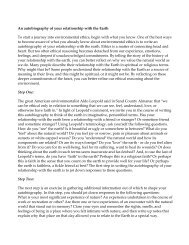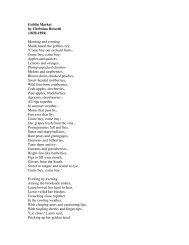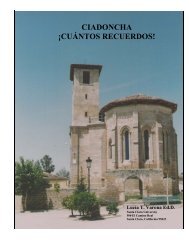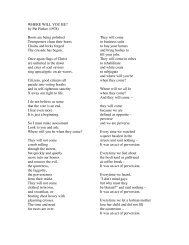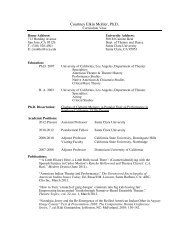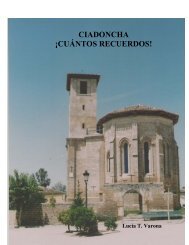ciadoncha; ¡cuántos recuerdos - Webpages at SCU - Santa Clara ...
ciadoncha; ¡cuántos recuerdos - Webpages at SCU - Santa Clara ...
ciadoncha; ¡cuántos recuerdos - Webpages at SCU - Santa Clara ...
Create successful ePaper yourself
Turn your PDF publications into a flip-book with our unique Google optimized e-Paper software.
The youth from the 70s and 80s had more freedom to go out and meet more<br />
people and the process of becoming engagement changed a lot. One participant told me<br />
th<strong>at</strong> during those years she really did not think about getting married. She said th<strong>at</strong> the<br />
youth back then saw marriage as a very serious thing. All of these youths studied outside<br />
of Ciadoncha and were exposed to a gre<strong>at</strong>er cultural diversity. Many youths began to<br />
travel and all th<strong>at</strong> influenced its form to think.<br />
The youths from the nineties practically have not lived in Ciadoncha. These are<br />
the grandchildren of the n<strong>at</strong>ives of the town. They have been raised in the capitols and<br />
have a totally different way of thinking when it comes to the engagement and marriage.<br />
Something th<strong>at</strong> seems interesting to me is th<strong>at</strong> since I put some of the stories th<strong>at</strong> I have<br />
written about this town on the Internet, I have received several e-mails from the young<br />
people which in some way identify with the town and enjoy reading something th<strong>at</strong><br />
brings them closer to their elder’s town.<br />
Before, if a couple wanted to formalize their rel<strong>at</strong>ionship, then the man had to ask<br />
for his girlfriend’s hand in marriage. To do this, the groom and his parents went to the<br />
bride’s house and they had a formal meeting th<strong>at</strong> consisted in going out for dinner or a<br />
well prepared afternoon snack. The parents of the bride and groom talked and would<br />
decide when the wedding would be. It was custom for the groom to pay for the bride’s<br />
dress and the dormitory went to the f<strong>at</strong>her of the bride’s account. (Personal Interview,<br />
2006).<br />
Weddings were done during mass. In Ciadoncha, it was customary, like the rest<br />
of Spain, to elect a godf<strong>at</strong>her who would present the bride and a bridesmaid, who<br />
accompanies the groom to the alter. In some weddings, little boys who carry the rings<br />
enter the church first and then the bride with the godf<strong>at</strong>her, who normally was the f<strong>at</strong>her<br />
of the bride, while the mother and her son, who is the groom, wait in the alter.<br />
After the mass, the bride and groom their godparents, and some witnesses move<br />
to the sacristy to sign the marriage certific<strong>at</strong>e. Once the act is finalized, they move on to<br />
the meal, which is carried out in a restaurant.<br />
Large weddings in the town were done before the automobile existed. It is said<br />
th<strong>at</strong> they were parties th<strong>at</strong> lasted up to three days. This is because rel<strong>at</strong>ives came from far<br />
places and they had to <strong>at</strong>tend to them. There was a lot of food, music, dancing, and the<br />
whole town appeared to be partying. They would get married in the town’s church and<br />
the reception was done <strong>at</strong> home. In the majority of old wedding photos, before 1955, the<br />
brides wore a dark dress.<br />
112





